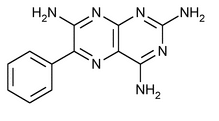Triamterene
(trye am' ter een).
» Triamterene contains not less than 98.0 percent and not more than 102.0 percent of C12H11N7, calculated on the dried basis.
Packaging and storage—
Preserve in tight, light-resistant containers.
Identification—
B:
A solution in formic acid solution (1 in 1000) shows an intense, bluish fluorescence.
Loss on drying  731
731 —
Dry it in vacuum at 105
—
Dry it in vacuum at 105 for 2 hours: it loses not more than 1.0% of its weight.
for 2 hours: it loses not more than 1.0% of its weight.
Limit of 2,4,6-triamino-5-nitrosopyrimidine—
Mobile phase—
Prepare a filtered and degassed mixture of 0.01 M potassium dihydrogen phosphate (adjusted to a pH of 3.0) and methanol (80:20). Make adjustments if necessary (see System Suitability under Chromatography  621
621 ).
).
Standard solution—
[note—Heating to 50 and sonication may be used to dissolve the 2,4,6-triamino-5-nitrosopyrimidine. ] Dissolve an accurately weighed quantity of 2,4,6-triamino-5-nitrosopyrimidine in methanol, and dilute quantitatively if necessary with methanol to obtain a solution having a known concentration of about 10 µg per mL.
and sonication may be used to dissolve the 2,4,6-triamino-5-nitrosopyrimidine. ] Dissolve an accurately weighed quantity of 2,4,6-triamino-5-nitrosopyrimidine in methanol, and dilute quantitatively if necessary with methanol to obtain a solution having a known concentration of about 10 µg per mL.
Test solution—
Transfer about 1 g of Triamterene, accurately weighed, to a 250-mL conical flask. Add 100.0 mL of methanol, and stir for 30 minutes with heating to 50 , cool, and filter.
, cool, and filter.
Chromatographic system—
The liquid chromatograph is equipped with a 330-nm detector and a 3.9-mm × 30-cm column that contains 10-µm packing L10. The flow rate is about 1.5 mL per minute. Chromatograph the Standard solution, and record the peak responses as directed for Procedure: the relative retention times are about 0.4 for 2,4,6-triamino-5-nitrosopyrimidine and 1.0 for triamterene; the tailing factor is not more than 1.5; and the relative standard deviation for replicate injections is not more than 2.0%.
Procedure—
Separately inject equal volumes (about 20 µL) of the Standard solution and the Test solution into the chromatograph, record the chromatograms, and measure the responses for the major peaks. Calculate the percentage of 2,4,6-triamino-5-nitrosopyrimidine in the portion of Triamterene taken by the formula:
10C / W(rU / rS)
in which the C is the concentration, in µg per mL, of 2,4,6-triamino-5-nitrosopyrimidine in the Standard solution; W is the weight, in mg of triamterene taken; and rU and rS are the peak responses for 2,4,6-triamino-5-nitrosopyrimidine obtained from the Test solution and the Standard solution, respectively: not more than 0.1% of 2,4,6-triamino-5-nitrosopyrimidine is found.
Ordinary impurities  466
466 —
—
Test solution—
Prepare a solution of Triamterene in dimethyl sulfoxide having a concentration of about 10 mg per mL. Quantitatively dilute with methanol to obtain a solution having a concentration of 0.25 mg per mL.
Standard solutions—
Dissolve an accurately weighed quantity of USP Triamterene RS in dimethyl sulfoxide to obtain a solution having a known concentration of about 10 mg per mL. Dilute this solution with methanol to obtain solutions having known concentrations of about 0.00025, 0.00125, 0.0025, and 0.005 mg per mL.
Procedure—
Separately apply 50 µL of each of the Standard solutions and the Test solution to a 0.5-mm thin-layer chromatographic plate that has been preconditioned by heating at 105 for 15 minutes and allowed to cool at room temperature in a closed chamber.
for 15 minutes and allowed to cool at room temperature in a closed chamber.
Eluant:
a mixture of ethyl acetate, 15 M stronger ammonia water, and methanol (90:10:10).
Visualization:
1.
Assay—
Transfer about 0.5 g of Triamterene, accurately weighed, to a 400-mL beaker, and dissolve in 250 mL of a solvent previously prepared by mixing, in the order named and with cooling prior to use, 1 volume of formic acid, 1 volume of acetic anhydride, and 2 volumes of glacial acetic acid. Titrate with 0.1 N perchloric acid VS, determining the endpoint potentiometrically. Perform a blank determination, and make any necessary correction. Each mL of 0.1 N perchloric acid is equivalent to 25.33 mg of C12H11N7.
Auxiliary Information—
Please check for your question in the FAQs before contacting USP.
| Topic/Question | Contact | Expert Committee |
|---|---|---|
| Monograph | Sujatha Ramakrishna, Ph.D.
Senior Scientific Liaison 1-301-816-8349 |
(SM22010) Monographs - Small Molecules 2 |
| Reference Standards | RS Technical Services 1-301-816-8129 rstech@usp.org |
USP35–NF30 Page 4930
Pharmacopeial Forum: Volume No. 27(1) Page 1823

